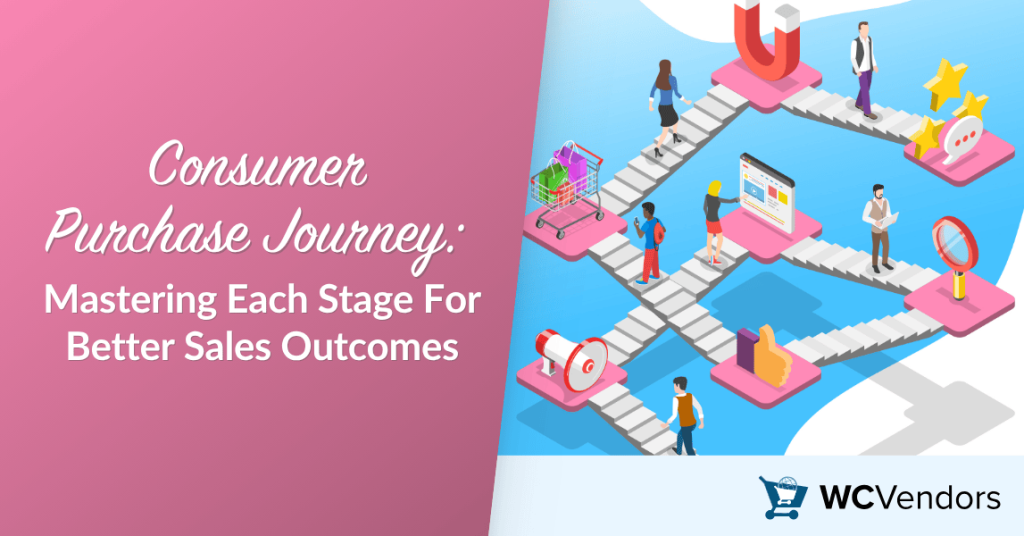
The consumer purchase journey shapes how buyers move from first discovering a product to passionately recommending it to others. Understanding the journey helps WooCommerce marketplace owners and vendors better guide buyers toward conversion.
By mastering each stage of the consumer purchase journey, you can improve conversions, customer satisfaction, and long-term marketplace success.
In this article, we will walk you through the five stages of the customer purchase journey and share how to optimize each stage. From creating awareness to fostering customer loyalty and advocacy, you will learn how to map the journey and deliver personalized experiences.
What Is The Consumer Purchase Journey?
The consumer purchase journey refers to the stages customers go through when deciding to buy a product or service. Mapping out this journey is vital for WooCommerce marketplaces because it helps understand customer motivations and behaviors at each stage.
The customer buying journey generally includes five key stages:
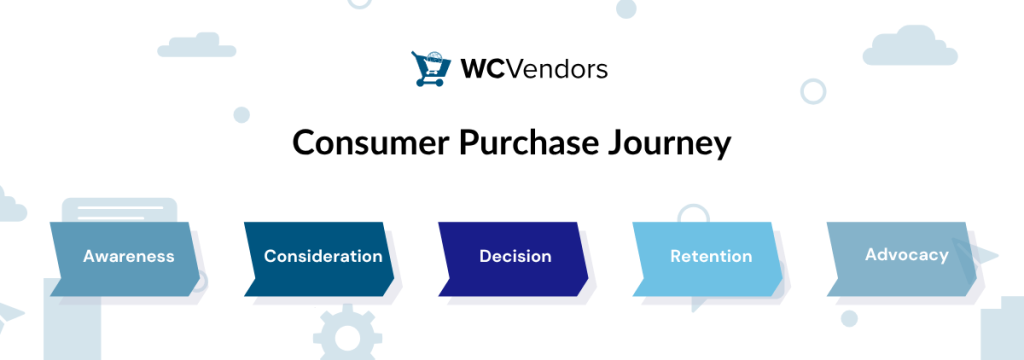
- Awareness Stage
- Consideration Stage
- Decision Stage
- Retention Stage
- Advocacy Stage
When it comes to B2B vs. B2C, the buying processes can differ. B2B customers often require more detailed information and longer consideration stages, while B2C buyers tend to be quicker and more impulsive.
Understanding the customer journey map and aligning it with marketplace buyer flows can help vendors create more targeted marketing strategies that increase engagement at every stage.
The 5 Stages Of The Consumer Purchase Journey
1. Awareness stage
The awareness stage is where buyers first become aware of a need or a problem. This is often the most crucial stage for WooCommerce marketplaces as it’s the starting point for turning a potential shopper into a customer.
How can marketplace vendors create visibility?
To capture the attention of potential buyers, vendors can use several strategies. Each of these plays an important role in getting your products noticed.
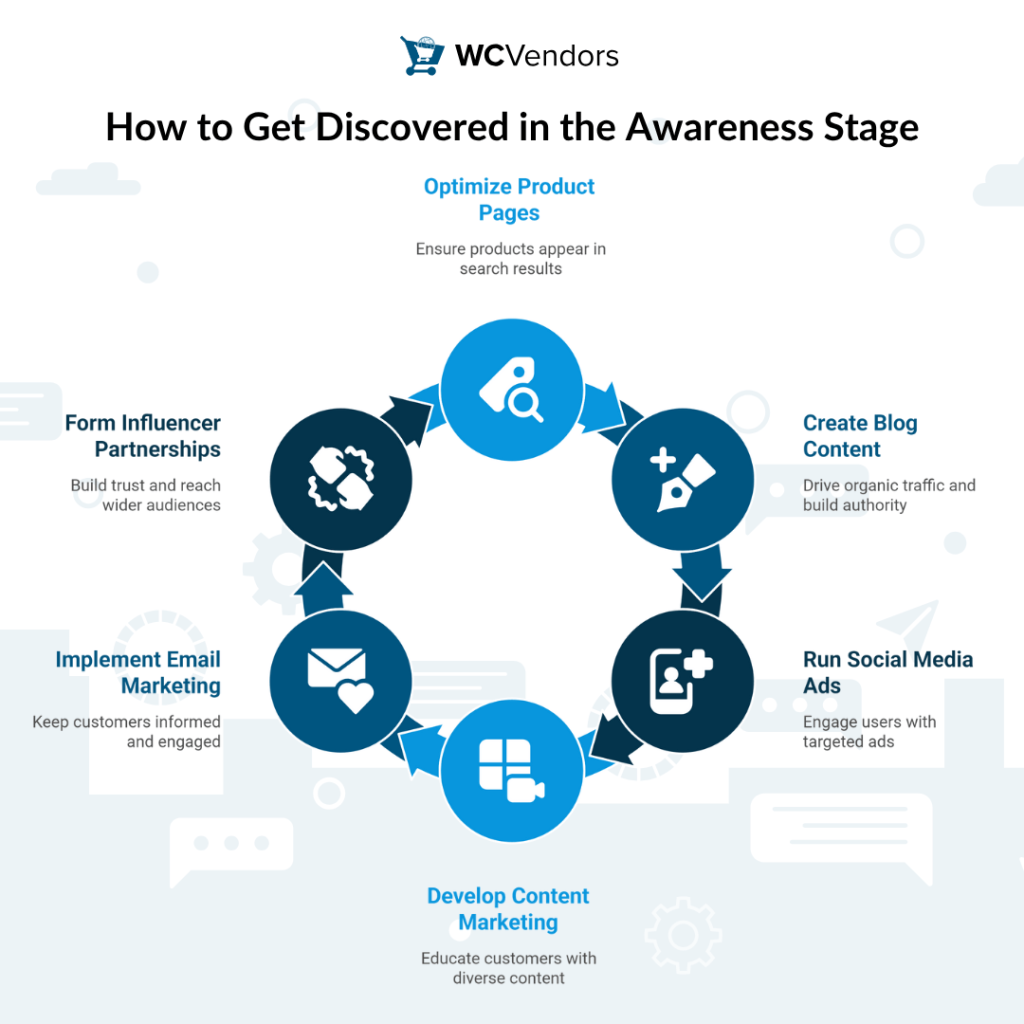
Here’s how they work:
- SEO: By optimizing product pages, vendors can ensure their products appear in relevant search results. This makes it easier for customers to find them when they’re actively searching for a solution.
- Blog content: Writing informative, value-driven blog posts that address customer needs helps drive organic traffic. It also builds your authority in the market, educating potential buyers about your products.
- Social media ads: Running targeted ads on platforms like Facebook, Instagram, or LinkedIn is a great way to build awareness. It also drives traffic to your store and engages users with specific product offerings that match their interests.
- Content marketing: Creating diverse content such as videos, how-to guides, and infographics across various channels can educate potential customers. This strengthens your brand authority and encourages prospects to explore your offerings.
- Email marketing: Sending out newsletters, product updates, or personalized emails helps keep your customers informed. It also nurtures engagement, driving interest in new products and encouraging them to take the next step in the buying process.
- Influencer partnerships: Collaborating with influencers who already have a strong following can build trust and credibility. Their endorsement reaches a wider audience and creates buzz around your product offerings.
As potential customers begin to explore your marketplace, using these strategies will help them recognize your products and move them one step closer to making a purchase.
2. Consideration stage
At the consideration stage of the consumer purchase journey, potential buyers begin comparing their options. They are now aware of their needs, and they’re considering various solutions. Vendors must focus on educating customers, building trust, and offering value.
How can marketplace vendors influence consideration?
Vendors can influence consideration by providing clear comparisons, answering questions, and showing reviews. These strategies help customers feel more confident as they decide what to buy.
Here’s how:
- FAQs and reviews: Offering comprehensive answers to common questions and displaying positive customer feedback can provide the reassurance that buyers need during their decision-making process.
- Product comparisons: Create side-by-side product comparisons that clearly highlight your unique selling points and advantages over competitors. This helps customers make informed choices.
- Case studies and testimonials: Sharing real-life examples and customer testimonials adds social proof, builds trust, and shows the practical effectiveness of your product or service.
- Targeted email campaigns: Send emails that go deeper into the features and benefits of your products or services, tailored to customers’ interests and preferences.
- Retargeting ads: Show ads across various platforms to remind customers of products they’ve already viewed or interacted with, reinforcing the purchase decision.
- A conversion-optimized landing page: Design a dedicated landing page that’s optimized for conversions, highlighting key product features and structuring content to guide customers toward making a purchase.
- Webinars or live demos: Host informative sessions where potential customers can see your product or service in action and ask questions, helping them feel more confident in their decision.
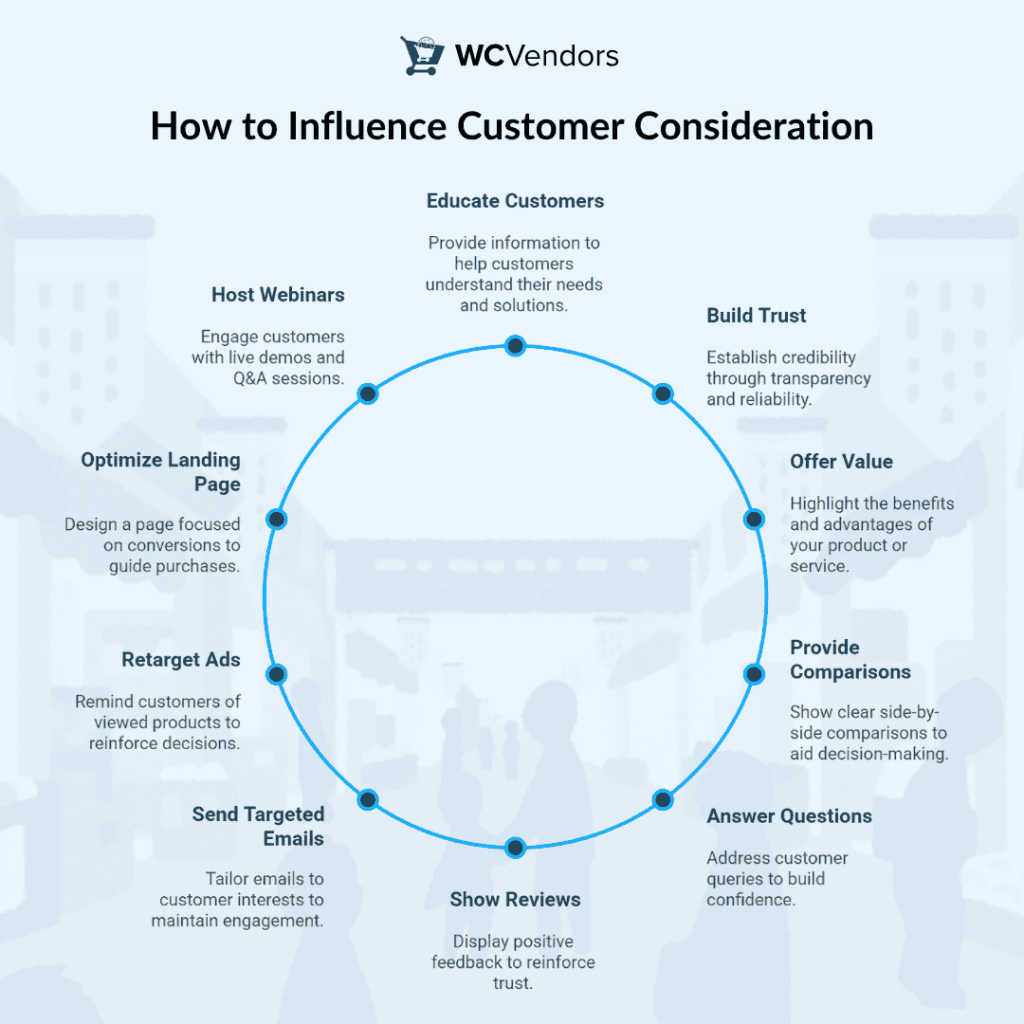
For marketplace owners using WC Vendors, vendors can easily add reviews, comparisons, and other trust signals directly to their product pages. This makes it easier for customers to gather the information they need to make the best decision.
3. Decision stage
This is it. The decision stage is where customers are ready to make a purchase. But before they hit “buy,” several factors can sway their final decision. At this stage, WooCommerce marketplace owners need to make sure their checkout process is quick and easy.
How can marketplace vendors make it easier for customers to decide?
Vendors can help customers make that final decision by focusing on clarity and convenience.
Here’s what works:
- Clear pricing: No one likes surprises. Make sure the price is upfront with no hidden fees.
- Urgency: A time-sensitive deal, like a limited-time offer, can encourage customers to act fast.
- Fast and simple checkout: Keep the checkout process simple. Remove anything that could distract or confuse customers. The easier it is, the more likely they’ll follow through with the purchase.
Once a customer clicks the “buy now” button, they’re in the purchase stage. It’s essential that this process stays smooth, with no bumps along the way. A fast, easy checkout leads to higher conversion rates.
How to increase order value during the decision stage?
When customers are ready to purchase, why not offer them a chance to spend a little more?
- Optimized checkout page: Keep it simple. Remove unnecessary fields and make sure prices are clear. Avoid adding ads or promotions during checkout.
- Order bump offers: While the customer’s in the checkout, offer them a relevant product at a great price. If it’s useful and affordable, they’ll likely add it to their order.
- Post-purchase upsells: After the sale, offer a quick upsell with more related products. Make sure these offers tie into what they just bought so it feels natural and valuable.
These strategies help increase the value of each sale without complicating the customer’s buying experience. It’s all about making it easy and adding a little extra value along the way.
4. Retention stage
Once a customer has made a purchase, the retention stage begins. The retention stage is about keeping your customers coming back for more. It’s not enough to make the first sale; you need to keep building the relationship.
How can marketplace vendors keep customers coming back?
After a customer buys something, it’s time to engage them and build loyalty. Here’s how:
- Loyalty rewards: Give customers a reason to return by offering discounts, points, or exclusive access. Everyone loves a good reward!
- Personalized follow-ups: Send a thank-you note or recommend products based on what they’ve bought. It shows you care and can spark future purchases.
For multi-vendor marketplace owners using WooCommerce, they can set up personalized follow-up messages, reminding customers of their next steps and offering incentives for future purchases. This helps build trust and keeps customers coming back.
How to drive more sales during the retention stage?
To drive more sales during the retention stage, focus on building long-term relationships with customers by staying relevant, consistent, and helpful after the initial purchase. Repeat sales often come from personalized engagement, timely follow-ups, and giving buyers a reason to return.
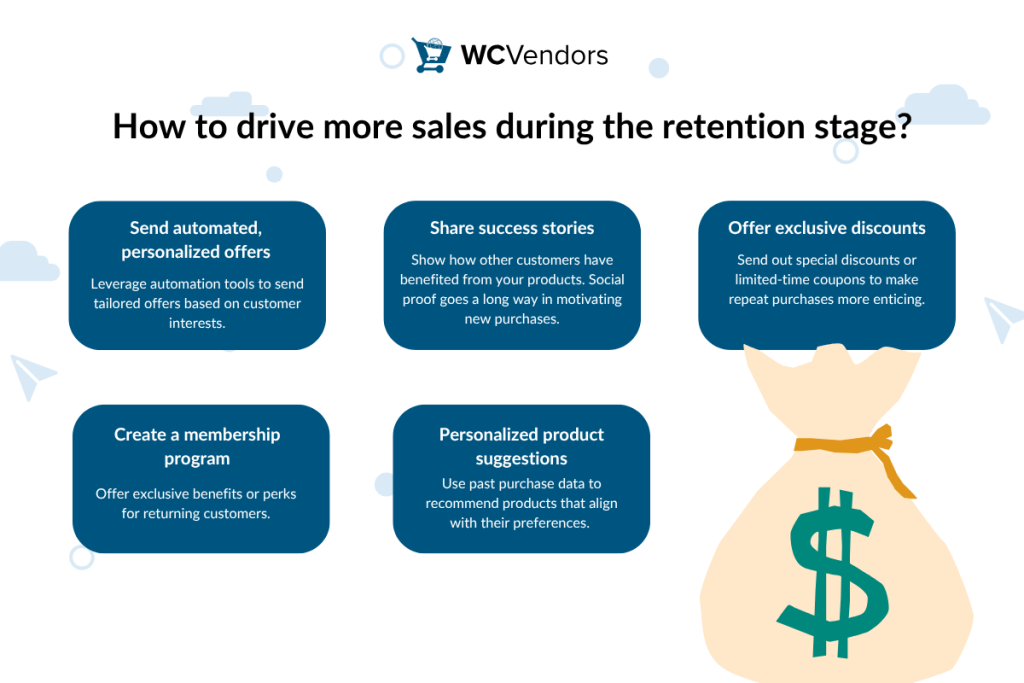
Looking to take your retention efforts up a notch? Here’s how you can keep customers engaged and increase repeat sales:
- Send automated, personalized offers: Leverage automation tools to send tailored offers based on customer interests. This keeps them engaged and nudges them toward their next purchase.
- Share success stories: Show how other customers have benefited from your products. Social proof goes a long way in motivating new purchases.
- Offer exclusive discounts: Send out special discounts or limited-time coupons to make repeat purchases more enticing.
- Create a membership program: Offer exclusive benefits or perks for returning customers. This makes them feel valued and more likely to stick around.
- Personalized product suggestions: Use past purchase data to recommend products that align with their preferences. It adds a personal touch and makes the shopping experience feel unique.
By using these strategies, you can turn first-time buyers into loyal, repeat customers. And that’s how the retention stage drives lasting growth.
5. Advocacy stage
When customers are happy, they don’t just stay loyal, they become champions for your marketplace. They’ll spread the word and share their positive experiences, bringing new customers in.
How can marketplace vendors encourage advocacy?
To turn satisfied customers into advocates, focus on encouraging them to share their experiences, provide feedback, and spread the word. This can be done through reviews, referral programs, and engaging them with your brand on social media.
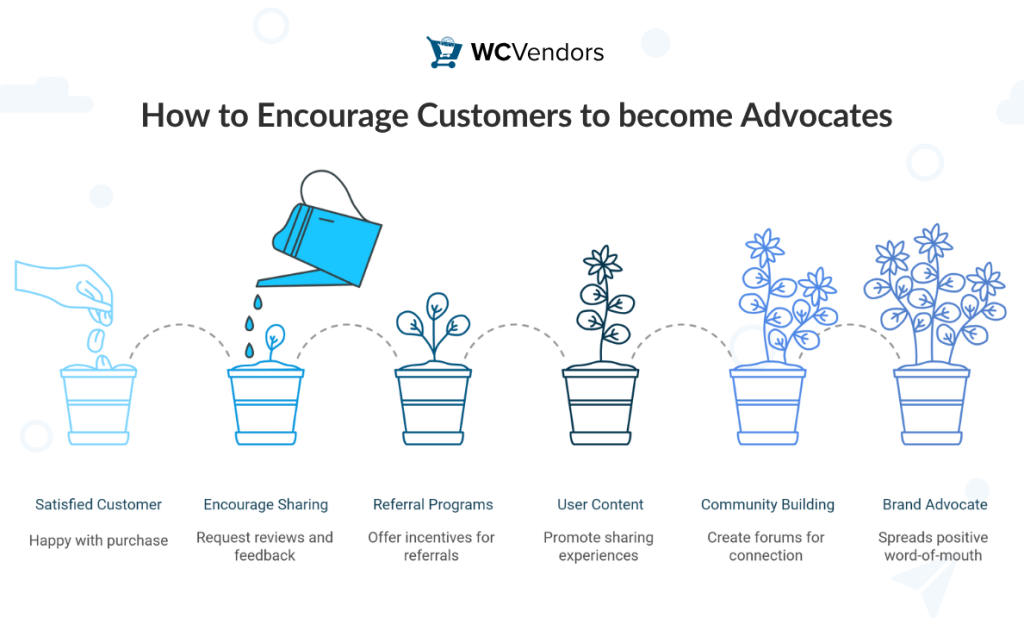
Here’s how:
- Request reviews: Ask happy customers to leave reviews. A simple reminder can make a big difference in gathering feedback.
- Referral programs: Offer incentives to customers who refer friends and family. This turns your loyal buyers into active promoters.
- User-generated content: Encourage customers to share their experiences on social media or in reviews. It builds trust and spreads positive word-of-mouth.
- Automated review requests: Use email tools to remind customers to leave reviews or share their thoughts online after their purchase.
- Referral rewards: Reward customers for bringing in new ones. The more they refer, the more they earn.
- User-generated content campaigns: Ask customers to share photos or stories on social media, sometimes with fun contests or hashtags.
- Community building: Set up online forums or groups where customers can discuss their experiences, share tips, and connect over your products.
- Customer highlights: Feature customer stories or testimonials in your marketing materials. Real-life examples can build social proof and influence others to join in.
By encouraging advocacy, you not only retain loyal customers but also turn them into powerful marketing assets for your marketplace.
Conclusion
Understanding and mastering the consumer purchase journey in your WooCommerce marketplace can make all the difference in customer satisfaction and boosting conversions. By fine-tuning each stage, from awareness to advocacy, you can create a personalized shopping experience that keeps customers coming back for more.
To recap, the five stages of the consumer purchase journey are:
- Awareness: When customers first discover your product or service.
- Consideration: When they evaluate different options and seek more information.
- Decision: When they’re ready to make the purchase.
- Retention: Keeping customers engaged and encouraging repeat purchases.
- Advocacy: Turning happy customers into loyal brand advocates.
If you’re ready to take your WooCommerce marketplace to the next level and improve the consumer purchase journey, check out our pricing plans and explore the WC Vendors live demo.
Frequently Asked Questions
How can I optimize my WooCommerce marketplace for higher customer retention?
Retention is about keeping customers engaged. Offer loyalty programs, send personalized follow-up emails, and keep customers updated on new products. Use data to recommend related items based on their purchase history to keep them coming back for more.
What are some effective strategies to increase customer advocacy in a multi-vendor marketplace?
Encourage advocacy by setting up referral programs, offering incentives for social media mentions, and featuring satisfied customers in your marketing campaigns. It’s all about building trust and incentivizing customers to share their positive experiences with others.
How can I use the customer purchase journey to optimize my marketing campaigns?
By understanding the stages of the consumer purchase journey, you can tailor your marketing campaigns. In the awareness stage, use SEO and ads. In the decision stage, offer discounts and targeted content. Personalized email campaigns can increase conversions in the retention stage.
What’s the difference between B2B and B2C customer journeys in marketplaces?
The B2B customer purchase journey is typically longer, with more focus on building relationships and trust through detailed product specs and negotiations. B2C journeys tend to be quicker and are often driven by convenience, emotional appeal, and clear pricing, especially in a marketplace setting.
How can I measure the effectiveness of my consumer purchase journey optimizations?
Use analytics tools to track customer behavior, such as time spent on site, bounce rates, and conversion rates. Monitor key metrics like cart abandonment and customer feedback. These insights can help you identify areas of improvement and refine your marketplace strategy for better results.
